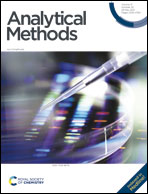Polymer-capped CdSe/ZnS quantum dots for the sensitive detection of Cu2+ and Hg2+ and the quenching mechanism†
Abstract
In this work, poly(styrene-co-maleic anhydride)-capped CdSe/ZnS quantum dots (QDs) aminolyzed with ethanolamine are proposed as fluorescent probes for the detection of Cu2+ and Hg2+, and two different quenching mechanisms are discussed in detail. The coordination abilities of the surface polymer of CdSe/ZnS QDs and two metal ions are calculated by density functional theory (DFT). The photoinduced electron transfer from excited QDs to Cu2+ unoccupied orbitals is enhanced due to the coordination between Cu2+ and the surface polymer of QDs. The electron transfer consumes non-radiative energy and performs fluorescence quenching. For Hg2+, the formation of HgS and the slight aggregation of polymer-coated CdSe/ZnS QDs lead to fluorescence quenching. The probe is sensitive to both Cu2+ and Hg2+, and the response can be detected within 1 min without adjusting the pH. With the addition of a masking agent, Cu2+ and Hg2+ can be exclusively detected in coexistence with another ion. For Cu2+, a linear relation in the concentration ranging from 0.02 to 0.7 μM was found between the relative fluorescence intensity (F0/F) and the concentration of Cu2+; the limit of detection (S/N = 3) is 6.94 nM. For Hg2+, a linear relation ranging from 0.1 to 1.4 μM was found between ln(F0/F) and the concentration of Hg2+; the limit of detection is 20.58 nM.



 Please wait while we load your content...
Please wait while we load your content...